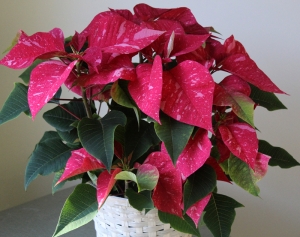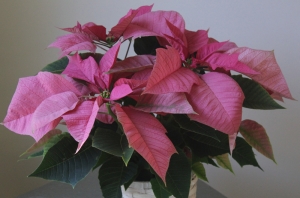[vc_row][vc_column][vc_column_text]Christmas at Studley’s means Poinsettias! Most people do not realize that the hundreds of gorgeous Poinsettias you find in our shop during the holidays are actually grown right here in our greenhouses. Beginning in July, we go to work nurturing these plants from a tiny cutting to the lush, mature and varied specimens we bring you in December:
-
-
- Red Poinsettia
- Pink Poinsettia
- White Poinsettia
- Yellow Poinsettia
- Marbled Poinsettia
- Speckled Poinsettia
-
No matter which variety you choose, you can be sure their beautiful showy bracts, against deep green leaves, will create a festive holiday display. View and order our Poinsettia varieties online.
Poinsettia Legend

The Poinsettia was introduced from its native Mexico in 1828 by Dr. Joel Roberts Poinsett. Most plants associated with Christmas have a legend, and the Poinsettia is no exception.
Although there are several different versions of the legend of the Poinsettia, the general story is as follows…
One Christmas Eve long ago, a young Mexican girl was very sad because she had no gift to present to the Christ Child at church services that night. An angel heard her crying and came to tell her that even the most humble gift, given in love, would be acceptable in His eyes. Encouraged, the young girl gathered a bunch of roadside weeds. As she placed them on the altar at church, she kneeled and began to pray. Soon, she became aware of the murmuring of the crowd. When she looked up, she was amazed to see her humble weeds were now a beautiful bouquet of dazzling scarlet flowers! This is how the Poinsettia became known as the “Flore de la Noche Buena” – Flower of the Holy Night.
How To Care for Poinsettia
To keep your Christmas Poinsettia in good health, remember the following:
-
-
- Purchase from a local florist, greenhouse or garden center who will properly wrap your plant upon purchase, and avoid the pre-wrapped versions.
- Poinsettia release natural ethylene gas – if pre-wrapped and kept in plastic for an extended period, the gas will sit on the leaves causing leaves to fall off.
- Choose plants with deep, green, healthy leaves and small green or yellow-green buttons (cyathia) in
the midst of the brightly colored bracts. These buttons are the true poinsettia flowers; if they are
absent then the plant has “bloomed-out” and is past its prime. - To prolong the bright color of the bracts and to prevent leaf drop, the temperatures should not exceed
72 degrees during the day and 60 degrees at night. - Plants require protection while transporting.
- Temperatures below 50 degrees will cause the leaves to drop.
- Keep plants away from drafts.
- Poinsettias do not require a lot of water. Water them every three to four days when they are on the
dry side. Avoid getting water on the foliage and bracts. Discard excess water that collects in the
plant tray or foil wrap to avoid root rot. - Place plants where they will get at least 6 hours of bright, indirect light.
- If your Poinsettia has a time-release fertilizer mixed in with the potting soil, then it will not need to
be fertilized. If no fertilizer is in the mix, give it at least one application of a regular houseplant fertilizer. (Note: Time-release fertilizer appears as small green or tan beads in or on the soil surface.)
-
My Poinsettia Re-Flowering Pro Tip!
To encourage your Poinsettia to re-bloom, it is absolutely vital to give it at least 14 hours of total darkness per day. Even a small amount of light can interrupt this process. Follow this regimen for at least 8 weeks to simulate the short day/long night cycle, which induces Poinsettias to set bud and bloom.
Note: DO NOT leave your plant in total darkness for 24 hours. The term “total darkness” does not mean darkness
for the entire day. Bring out that beautiful plant you’ve produced for all the world to see!
Pets and Poinsettia – Know The Facts
Contrary to popular belief, Poinsettias aren’t poisonous to pets. According to the ASPCA, pet Poinsettia ingestion can be irritating to the mouth and stomach, sometimes causing vomiting, but is generally over-rated in toxicity. The Pet Poison Helpline explains further.
See you at Studley’s!

[/vc_column_text][/vc_column][/vc_row]





Pingback: Winter Plant Care | Studley's Flower Gardens